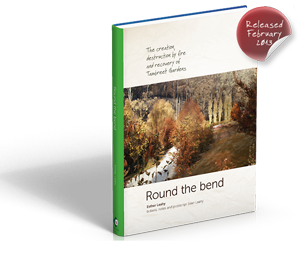 The creation, destruction by fire and recovery of Tambreet Gardens
The creation, destruction by fire and recovery of Tambreet Gardens
Review by Penny Woodward
Probably the most interesting gardening book I have read this year, this is the story of a garden created, lost and then recreated. Esther and Sean Leahy moved to the property, a small farm on six acres in 2003 and over the following six years created a garden and retreat. Then on the 7th of February 2009 in the Black Saturday fires, the garden was destroyed, although they managed to save the house. In beautiful prose, Esther describes the process of watching the garden recover and then recreating the garden. I love the descriptions of trees they thought lost, but with great patience they waited, many started to regrow although it sometimes took two years before they could be sure. Some would regrow but then fall victim to winds or pests. Each one feels like a friend. Many of the Australian plants survived by putting out epicormic growth, or reshooting from the ground. But surprisingly many introduced trees recovered too. Oaks, maples, ginkgoes, liquid ambers and coast redwoods being some, although many took three or more years before they were back to their normal cycles. In the end the survivors were pretty much equally divided between native and non-native. They also watched the insects, spiders, reptiles, birds and mammals slowly returning. Some in plague proportions, but eventually the balance was restored. A steady stream of family and friends aided their own long hours of labour, but now, four years later the garden is nearly completely recovered.
Round the Bend was created from Esther’s diary, written during the garden’s re-emergence. Sean Leahy, aka The Gardener, added Latin names, botanic words and phrases. Here Esther describes the return of a Kookaburra.
‘January 2010 Dusk is eerily quiet, as it has been for almost a year, and then we hear that maniacal cry, that crazy chortle. There he is, a returning laughing kookaburra, just one, a study in patience……… He serenades the setting sun. We hope he is not alone for long.’There is a cornucopia of photos, with many showing before and after and then later again. The lovely design of juxtaposed photos and text allows you to dip in, or read page after page. It seemed a little complicated at first, but once I’d become used to it, it was just as it should be: a mosiac of the years passed, plants grown, people and animals seen.
Gardeners will be fascinated to read about just how much of the garden grew back. Sean Leahy sums it up when he says, ‘Tambreet’s survival and regrowth has astonished us, from the smallest perennials like poppies and foxgloves growing from seeds that must have been deep within the earth ……….to huge gums and oaks with coppice growth and resilience.’
Round the Bend will help gardeners to make decisions about what to plant in fire prone regions and contribute to the debate on what plants might offer protection in properly planned and planted gardens.
Resilience is the attribute that shines though in this story, whether plants or people. If you are a gardener, get yourself a copy (or get your library to buy it in), you will be saddened by the losses but delighted by the vignettes of survival of so many plants and creatures great and small.
by Esther Leahy Available online from tambreetretreat.com.au, $66 plus postage
